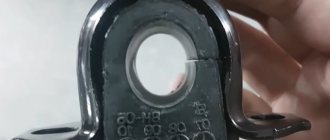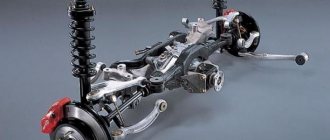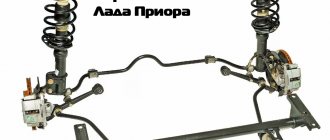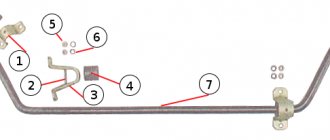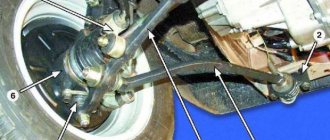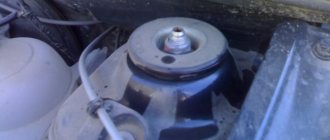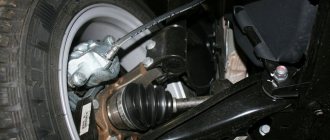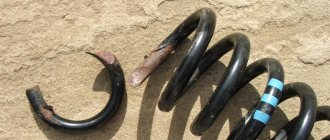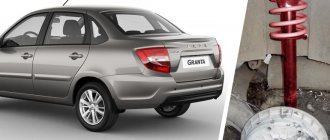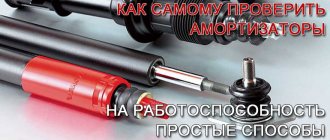The front and rear suspension of Vesta differs significantly from the one that AVTOVAZ used on Grant, Priora, Kalina, etc. All the reviews tell us that the new chassis design is better than before. However, during the first months of operation, the owners began to notice extraneous noises (knocks, creaks, rattles, crunches) in the front and rear suspensions of Vesta, which occur when driving over speed bumps or other road irregularities...
Rattle in the front suspension on Lada Vesta
The most common cause of squeaking is the stabilizer bushing
The increasing grinding noise of the front suspension of the Lada Vesta is especially worrisome, because the main load , the steering and braking systems are located, the condition of which must always correspond to the norm.
A front-wheel drive car, as in our case, is prone to problems with the nose.
Creaks in the suspension are Vesta's disease!
Even new Vestas begin to creak after a short period of operation.
Inspection of the front suspension.
The very first cause of the malaise is considered to be an unfinished design of polyurethane stabilizer bushings , which almost immediately begin to make groaning sounds when driving through plump speed bumps. In wet weather he begins to moan constantly, which is very exhausting.
This problem can be corrected in several ways, radical and not so radical:
- Replacement of pillows with analogues from Chevrolet Niva or other suitable foreign cars.
- Regular application of mastic to places where polyurethane rubs against metal.
- Wait until AvtoVAZ corrects the defect, inviting everyone to the service station for a replacement.
Rear suspension problems
When driving over bumps, noise may also appear in the rear suspension. Defects in the rear suspension are accompanied by unpleasant squeaks, which can be eliminated by installing a gasket on the shock absorber in the upper support.
It could also be wheels that were poorly tightened when replaced. An urgent stop and tightening of the wheel is necessary. Disturbing noises can also be caused by a clogged trunk; before suspecting a problem, you should empty the trunk and make sure that the cause is deeper. If the squeaks have not disappeared, you should start eliminating them.
Problem with stabilizer links
The problem with squeaks in the front suspension can be solved by replacing the stabilizer bushings with polyurethane.
If after performing one of the operations the grinding does not stop, then you can go further down the list.
What else could be wrong with stabilizers? The design has a strut that is attached to the shock absorber body and the cross member of the stabilizer itself. It has two fingers as fastening. Without diagnostics at a service station, it will not be easy to figure out whether there is a breakdown in this unit, but you can try.
Official opinion of AvtoVAZ
Dealers replace stabilizer links free of charge. But sometimes you have to butt heads!
The problem with the struts is not far-fetched , since in April 2021, official representatives of AvtoVAZ reported that they knew that after just a few thousand kilometers Vesta was already detecting knocking and creaking noises from this particular unit. This important element experiences special stress and wears out prematurely.
There was no word on whether the fault was a manufacturing defect.
Replacement of struts on Lada Vesta for free
Replacement of squeaking elements at the dealer should be free of charge. All questions can be resolved by calling the hotline!
However, all car owners who complain about the performance of the struts during the warranty period will have them completely replaced at the dealership free of charge .
It is noteworthy that we are not talking about installing a repair kit, but a complete replacement of the unit.
So, if the warranty has expired, you will have to try to solve the problem yourself. The replacement process is simple. After inspecting the removed parts, you can decide whether to replace the entire mechanism or limit yourself to a repair kit.
Creaking of handles, door trims and door seals
Even if your car is new and under warranty, contacting an official dealer most often does not yield any results. For this reason, you will need to solve this problem yourself. If you notice that you hear a squeaking sound from your car doors while driving on an uneven road, you need to think about eliminating it. The noise emitted from the door cards inside the car can be created simultaneously by the passenger door handles (this does not apply to the door handles) and the decorative door trims.
Door handles and doors themselves
First of all, you need to determine which specific element is creaking. If door handles do this, you need to purchase madeleine and a set of plastic spatulas that remove the trim. Madeline is a special material. It is often used at the junction of elements to eliminate the likelihood of friction against each other. You can purchase it at all automobile stores.
The door handle linings are retained with latches and do not have an additional holding device. For this reason, they are removed using careful bending of the element. It is advisable to do this using plastic spatulas. They will not cause damage to the element and its fasteners. After removing the door handle trim, it is necessary to glue the place where it touches the door card with Madeleine.
In addition, it is possible to get rid of squeaks by using material created by the spunbond method. In this situation, a piece should be cut out of the material with a shape slightly larger than the problematic element. Then the spunbond is placed between two fastened elements. After installing the element on top of the material, the remaining material must be trimmed using a stationery knife for this purpose. To ensure that the material is not visually noticeable in the opening between the elements, it is tucked inside using thin objects such as a toothpick, screwdriver or plastic spatula.
Creaking sounds coming from the doors can occur not only due to door handle linings, but also due to decorative bezels. In this situation, eliminating the squeak will be more difficult. This is explained by the fact that these linings have one negative quality: the fasteners on them will not snap back into place.
Removing the decorative trims is just as easy as removing the door handle trim. After they are removed, you need to glue the place where the two elements touch. Difficulties may arise when trying to return the pads to their original places, their latches do not turn on. As a result, you will need to completely remove the door card.
If, as a result of the inspection, it was discovered that after removing the door panels and gluing all joints with carpet or madeleine, the creaking sound will remain, you should check whether the door seals are creaking. If you turn them out a little, you will notice small round holes every 20 centimeters. As it turned out, it is necessary to pour lubricant specifically into these holes, and in this case the creaking will stop sounding.
It is quite possible that in dry weather dust accumulates over time, which is why the creaking begins. Classic silicone grease will be useful for the job. In addition, in rare cases situations arise when the door lock makes a creaking sound. In this situation, it is also advisable to lubricate it.
Panels creak
One of the most important and popular problems with the Lada Vesta car is its dashboard, and more precisely, the squeaking noise it creates. Creaking may appear already in the first months of using the machine. You can get rid of this problem by eliminating dashboard creaks with your own hands.
To do this, you will need specialized madeleine material. Often it is sold ready-made in the form of a meter tape. Its thickness is 1 mm. For convenience, one of its sides was coated with special glue. This material is sold in all stores selling car accessories.
To eliminate dashboard creaks, first of all, you will need to disassemble it. This is easy to do and will not require you to waste a lot of time. First, unscrew the two Torx bolts. It is thanks to them that the panel wells do not leave their correct place.
Then the wells will be secured using latches installed on the inside. To unhook them, you just need to carefully move the wells by their bottom.
The dashboard itself is also attached thanks to two Torx bolts located along its edges. After removing the fasteners, you only need to separate the cable that powers your dashboard. After this, you will see a completely empty area where the panel was previously located. This is where you have work to do.
It is noticeable even to a non-professional that all the mounting points and the wells themselves are generally made of low-quality plastic. Actually, thanks to this plastic, creaking occurs in the dashboard, and to eliminate it, it is necessary to reduce the contact between these plastic elements. You can solve this problem using the previously described tape. Cut it into small pieces. Its length is 3-4 cm. Then paste it over all permissible places of contact of the plastic.
Glovebox creaks
Unusual unpleasant sounds, namely creaking, may occur in the glove compartment of a Lada Vesta car. This may be caused by duct problems. It is attached to the glove compartment in the lower part on one side.
Eliminating problems in the glove compartment design is not at all difficult. The air duct is attached to the glove compartment using two bolts. You just need to disconnect the glove compartment and the air vent from each other. First you need to remove the bolts. The air duct removed from the glove compartment must be turned over, since this side of the air comes into contact with the glove compartment and causes a squeak. To prevent this from happening, you need to buy an anti-creak. It is a material with special qualities. When installing the glove compartment in the place required by the state, you need to take special care. A slight shift of the glove compartment from its normal location can cause problems with the flow of air into the cabin. The latch, located directly in the glove compartment, must fit onto the mount. Next you will need to install the bolts and side panel hook.
Other causes of squeaks in the front suspension
Lada Vesta does not have any other serious problems other than those listed above.
The front suspension is designed reliably, similar to foreign brands, taking into account long-term use.
Quite often, extraneous squeaks are caused by brake calipers.
There are isolated cases where the following types of breakdowns have occurred over time:
- The silent blocks of the steering gear levers require , which are extremely inconvenient to remove.
- Brake calipers may gradually begin to click , replacing the pins may solve this problem.
- A small play appears in the place where the strut cups are attached to the body , associated with wear on the threads of the mounting bolts.
What are these squeaks and knocks?
In fact, there are a great many reasons why extraneous noise may occur in the front suspension, and first we will try to understand what kind of sound is disturbing your nerves and hearing.
Noise - a similar sound is produced from rubbing parts that come into contact with each other.
Knocking - occurs from parts in which play has formed in the assemblies. This type of malfunction most often occurs due to natural wear and tear.
It also happens that both of these unpleasant sounds are emitted from parts simultaneously, and it will be a little more difficult to understand what has become unusable.
Looking for a sound source in the front suspension
First of all, what needs to be determined is from which direction this very sound is coming. This will not be difficult to do, because sounds will appear either when turning in one direction or the other.
When the side is found, on the inverted wheels, inspect the integrity of the boots on the constant velocity joints (CV joints), and if there are breaks, dirt and sand have probably already gotten inside and mixed with the lubricant, therefore (depending on the condition of the CV joint itself) they may need to be replaced.
External CV joint. The boot must be without damage and without traces of oil.
The failure of the CV joint is quite easy to determine. On fully turned wheels, a specific cracking noise is emitted at the beginning of movement, which stops when stopping or changing the angle of rotation.
Creaks due to silent blocks, ball joint or support bearing
If this is not the reason, then again, with the wheels turned out on the “noisy” side, inspect the condition of the silent blocks, ball joint, and support bearing.
For clarity, the lever has been removed from the car (the places of squeaks are marked in the picture)
No wonder it creaks. The support bearing is broken
In addition to all of the above, please note that the malfunction can be combined and consist of several breakdowns. Therefore, the entire Renault Logan steering system must be checked as a whole.
Cup support creaking (Renault Logan disease)
A fairly common situation is when an extraneous squeak comes from under the rubber seals of the strut support (cup). In this case, it is necessary to check their condition; most likely, the lubricant has come out. In this case, it is necessary to hammer new lubricant into this element. Otherwise, only replacement and checking the condition of the shock absorber struts.
This is done as follows.
- Hang one side on a jack. This will allow the opposite side (cup) to rise.
- Drive new grease into the resulting gap. We recommend a thick silicone lubricant.
Lubricants must be filled into the resulting gap between the glass and the body.
This is what the finished result looks like
Creak from steering rods and steering rack
This fault can be easily identified with a partner. To do this, with the car turned off, you need to unscrew the wheel first to the left until it stops, and then to the right. This needs to be done several times. At this time, your partner should try to hear the source of the squeak. If these are steering tips, then hearing them will not be difficult. About replacing steering tips here, about their choice here.
Listen here. Also inspect the condition of the anthers
Also pay attention to the rubber boot of the tip; it should not be “broken.” If there are cracks on it and it is “snotty”, then the CV joint boot needs to be replaced.
If the sound comes from the rack when the steering wheel is rotated, you can try tightening the rack itself.
conclusions
In addition to these factors, time plays a decisive role.
If the service life of some units has come to an end, then they need to be replaced urgently, since one breakdown can lead to others, and the entire mechanism will go into disarray.
If we return a little to squeaks, then with significant fatigue of the ball joints, steering tip and rack, failure of the shock absorber, or its broken supports, unnatural irritating sounds may appear. Then it is best to go for a diagnosis and then treat the problem.
Wheel squeaking when turning grant: causes and solution to the problem
When driving on uneven roads, as well as due to improper tightening, the nuts become loose, which is why a knock is heard in the suspension when cornering and when driving over uneven surfaces. This is a very dangerous symptom, because if the nut is completely unscrewed, the suspension will fail and the car will lose control.
Lada Granta is a modern car produced by a domestic manufacturer and maximally compliant with Western standards. But no matter how hard the designers tried, problems remained. One of them is a knocking sound in the wheel area on the Lada Granta when turning the steering wheel.
